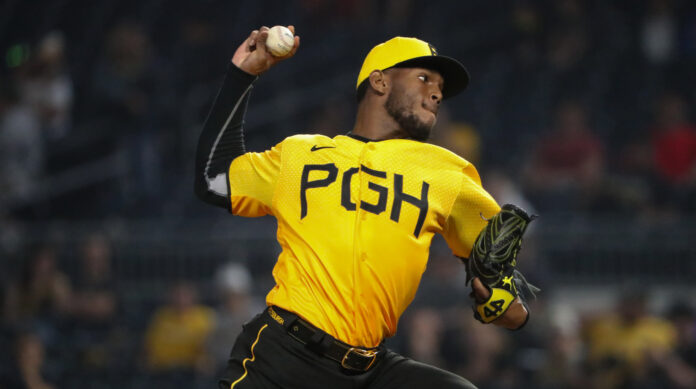Every week on Pirates Prospects, I’ll be digging through the Statcast data on Baseball Savant to highlight three players who stand out for their pure stuff. As Spring Training winds down, this week I’m focusing on two pitchers who can help in the big leagues on Opening Day, as well as a prospect who stands out as a sleeper to reach the majors one day in relief.
Jared Jones, RHP
There was no Statcast data available for last Saturday’s start from Jared Jones. The statline of four shutout innings, with two hits, one walk, and four strikeouts, was elite. The fact that these numbers came against the Major League lineup of the Atlanta Braves adds more excitement.
Jones has excelled when tracked by Statcast data. In his outing on March 10th, he hit 98 MPH or higher ten times in 42 pitches, with his fastball averaging 97.8 MPH. On that day, the fastball led to four whiffs and two called strikes, for a 27% CSW rate. His slider was more effective, with seven whiffs on nine swings across 15 pitches, leading to a 53% CSW.
It was the same story on March 5th. He threw 27 pitches on the day, with 14 of those going 98+ MPH. Jones touched 101 with his fastball, and averaged 99.3 MPH with a 2630 average spin rate. The fastball led to a 33% CSW, while the slider didn’t generate any whiffs on that day. He did have three whiffs in eight swings on the slider across his previous two appearances.
Jones mostly works with the fastball/slider combo, and both are elite pitches. When one of them isn’t working, he still has a plus offering, along with a curveball and a changeup. When both his four seam and slider are working, Jones is one of the most dangerous pitchers the Pirates can put on the mound. He’s making a strong case to start the year in the big league rotation, allowing him to show what that pitch combo can really do against big league lineups.
Roansy Contreras, RHP
Roansy Contreras could use a sinker, and a simplified approach in the bullpen. On Monday, the right-handed pitcher displayed an elite slider, generating eight whiffs on nine swings, with five called strikes. Contreras threw the slider 23 times, and resulted in a called or swinging strike 57% of the time.
The four-seam fastball wasn’t as effective. The pitch generated a 21% CSW rate, with two whiffs and two called strikes. The pitch also resulted in both of the hits allowed by Contreras, as well as the ball four on two of his three walks.
The slider is consistently a good offering from Contreras. In his four inning appearance on March 13th, he generated five whiffs in 15 swings, with four called strikes. On that day, his four seam had ten called strikes for a 35% CSW on the day. It also led to his hardest hit pitches of the day, on a day when he gave up four runs.
His results on March 8th weren’t as good, with a 22% CSW on the slider, and only a 5% CSW for the fastball. On March 2nd, Contreras had a 30% CSW for the slider, and 17% for the fastball. Across all of these appearances, Contreras has seen an average exit velocity of 90+ MPH on the four seam, with several 100 MPH exit velos.
A sinker typically plays best off a slider. The movement of a sinker runs counter to the movement of a slider, forcing a hitter to determine whether a common looking pitch is going to break one way for the sinker or another for the slider. Contreras throws a curveball, which plays opposite of his four-seam fastball. His slider gets results. His four seam does not. Adding a sinker to complement the slider would help Contreras to gain deception on his fastball offering, by playing it off his best pitch.
You can throw a four seam/slider combo. Jared Jones is an example of this. The difference is that Jones has a good four seam, and Contreras does not. Without a reliable fastball, Contreras isn’t a good option for the rotation. He could play up in the bullpen, thanks to that slider. He would need something to set up the pitch consistently.
Valentin Linarez, RHP
I had a chance to see Valentin Linarez last summer in High-A Greensboro. On Monday, he came on to pitch the final inning against the Phillies. Linarez features a 96 MPH fastball, along with a plus slider. He threw 15 pitches on Monday, with the 83 MPH slider generating two whiffs in five throws and three swings.
What stands out to me about Linarez is that all of his pitches move. The average spin rate of his offerings on Monday was 2300 or higher. Both his four seam and sinker have a lot of spin, and his slider equals the fastballs. The fact that his fastballs are traveling 96, with that level of spin, makes them productive offerings.
I’d expect to see Linarez in Altoona this year, working out of the bullpen. He’s got the big frame to work multiple innings, and profiles as a power reliever in the future. His control will be the big thing to watch, with a 12.5% walk rate in High-A that went up to 18.2% in a brief stint in Double-A at the end of the year. Linarez had a similar trend in 2022, putting up an 11.3% walk rate in Low-A, before watching his rate soar to 18.8% at the end of the year in High-A. Perhaps he will improve his control numbers in Altoona in a more extended run through the level, like he did with his move to High-A.


